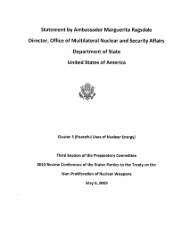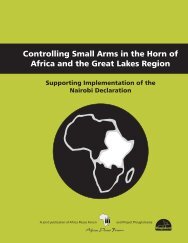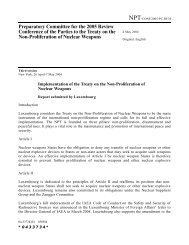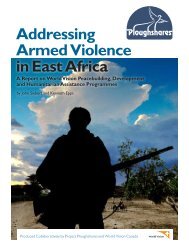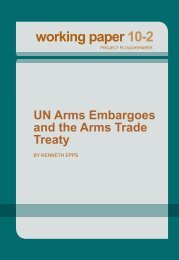wars. Criminal organizations employviolence in the pursuit of profit, notin pursuit of a political program. Andwhile groups engaged in politicallydriven combat often pursue criminalactivities for economic gain, the morebasic objective of such groups, andthe basic point of the violence theypractise, is still the pursuit of militaryand political goals (Ballentine &Nitzschke 2005, pp. 4-5).4Internally displaced Congolese women wait during a food distribution in Kibati,just outside the eastern provincial capital of Goma. © Les Neuhaus/IRIN.When public violencemeans warWhile war is eminently recognizable,defining it is not so simple. Becausecontemporary wars are not declaredand because, in most cases – especiallycivil/intrastate wars — they donot follow from a clear or official decisionto go to war, it is often not at allobvious whether a country is “at war”or not. So, any effort to count warsmust obviously include the applicationof some reasonably objective,measurable criteria for determiningwhen a war begins and when it ends.The tabulation of wars for theannual <strong>Ploughshares</strong> ArmedConflicts Report (<strong>2010</strong>b) is based 2on three characteristics:• It is a political conflict;• It involves armed combat by thearmed forces of a state or the forcesof one or more armed factions seekinga political end, such as gainingcontrol of all or part of the state;• At least 1,000 people have beenkilled directly by the fighting duringthe course of the conflict.In many contemporary armedconflicts the fighting is intermittentand involves widely varying levels ofintensity. Afghanistan and Iraqexperience persistent and ongoingarmed clashes and attacks. Rwandawent from political tension tounprecedented levels of violenceand back down again in a relativelyshort period of time. The wars in thePhilippines and Burundi are examplesof ongoing but relatively low-levelconflicts, with annual combat deathsnow often as low as about 100 – but,of course, with political, economic,and social disruption well out ofproportion to the intensity of actionon actual battlefields.The definition of “political conflict”obviously cannot be technicallyprecise. Nevertheless the distinctionbetween political and criminal violenceis significant and discernable.There are clear instances in whichescalating violence that is clearlycriminal becomes so extensive that ittakes on significant political overtonesand complications. The Mexican drug“war” is perhaps the most prominentcase in point. The fundamentaldispute is clearly not political – it isa matter of organized crime – butthe impact on the country and onMexico’s relations with its neighbours,including the US, is such thatit engages government at the highestlevel, as well as the armed forcesof Mexico.Still, criminal violence remainsdistinct from the armed conflict ofwar, and Mexico is not included inthe <strong>Ploughshares</strong> count of currentTypes of warA relatively simple typology of armedconflict relies on four basic categories:international or interstate war plusthree overlapping types of intrastatewar (state control, state formation,and state failure). 3Interstate warsAn interstate war is a war betweentwo or more states and, for purposesof <strong>Ploughshares</strong> reporting, must alsomeet the 1,000-combat-death criterion.Though rare, international warsare not yet banished from history. Butthe distinction between interstate andintrastate violence is often obscured.Interstate wars are frequently foughton the territory of just one of thestates in the conflict –as in the 2001-2002 US-led attack on Afghanistanand the 2003 US-led attack on Iraq.On the other hand, it is obviouslyalso the case that virtually all civilor intrastate wars include extensiveinternational involvement.Intrastate warsThere are three basic types ofintra-state conflicts.State control wars obviouslycentre on struggles for control of thegoverning apparatus of the state. Statecontrol struggles are typically drivenby ideologically defined revolutionarymovements or decolonization campaigns,or are simply the means bywhich power transfers from one set ofelites to another. In some instances,communal and/or ethnic interests arecentral to the fight to transfer power;in other instances religion becomesa defining feature of the conflict; andin others the differences are moreideological.The <strong>Ploughshares</strong> Monitor I <strong>Winter</strong> <strong>2010</strong>
Armed Conflicts in Africa 1987-2009DatesType of Conflict*ConflictsBeganEndedResumedEndedINT SC SF FSAlgeria 1993 XAngola 1975 2002 XAngola (Cabinda) 2003 2005 XBurundi 1992 XChad 1965 X XCongo (Brazzaville) 1994 1995 1997 2000 XCongo (Kinshasa) 1990 X XCôte d’Ivoire 2002 2007 XGhana (land issues in north) 1994 1996 XGuinea 2000 2002 XEritrea/Ethiopia 1998 2000 XEthiopia 1974 1992 2003 X X XKenya 1993 XLiberia 1990 1996 2000 2003 XMozambique 1977 1993 XNamibia 1966 1989 XNigeria 1999 XRwanda 1990 1990 1992 2002 XSenegal 1999 2004 XSierra Leone 1994 2001 XSomalia 1986 X X X XSouth Africa 1966 2000 X XSudan (North/South) 1983 X XSudan (Darfur) 2003 X XUganda 1996 X XWestern Sahara 1975 1991 XZimbabwe (ZANU/ZAPU) 1982 1987 XTotal 27 17 4 3 2 18 7 11*Type of conflict: INT = interstate SC = state control SF = state formation FS = failed stateState formation wars centre on the form or shape ofthe state itself and generally involve particular regions of acountry fighting for a greater measure of autonomy or foroutright secession. Communal ethnic or religious claimsare frequently an element of such wars.Failed state wars are conflicts that are neither aboutstate control nor state formation, but are focused on morelocal issues and become violent in the absence of effectivegovernment control. The primary failure is in the lackof government capacity, or sometimes will, to provideminimal human security to groups of citizens. Pastoralistcommunities in East Africa, for example, usually live wellbeyond the reach of the state. There are virtually no statesecurity services or institutions present and no politicalmeans of mediating disputes over cattle raiding or accessto grazing lands and water. Communities come into conflict;with access to small arms, an escalation of violence isalmost inevitable. The violence is political, although it isover local issues and none of the parties has state-controlor state-formation objectives. Such conflicts are includedin the <strong>Ploughshares</strong> count when the threshold of 1,000combat deaths is reached.Of the 81 wars that occurred during the last 23 years,51 per cent included state control objectives, 35 per centincluded state formation objectives, 25 per cent reflectedfailed state conditions, and 11 per cent included interstatedimensions. 4The <strong>Ploughshares</strong> Monitor I <strong>Winter</strong> <strong>2010</strong>5



